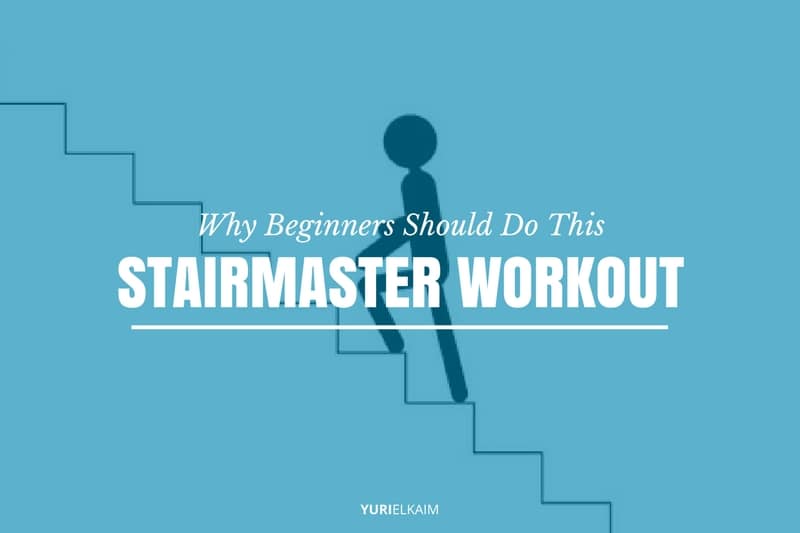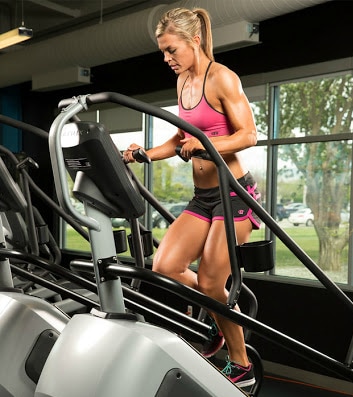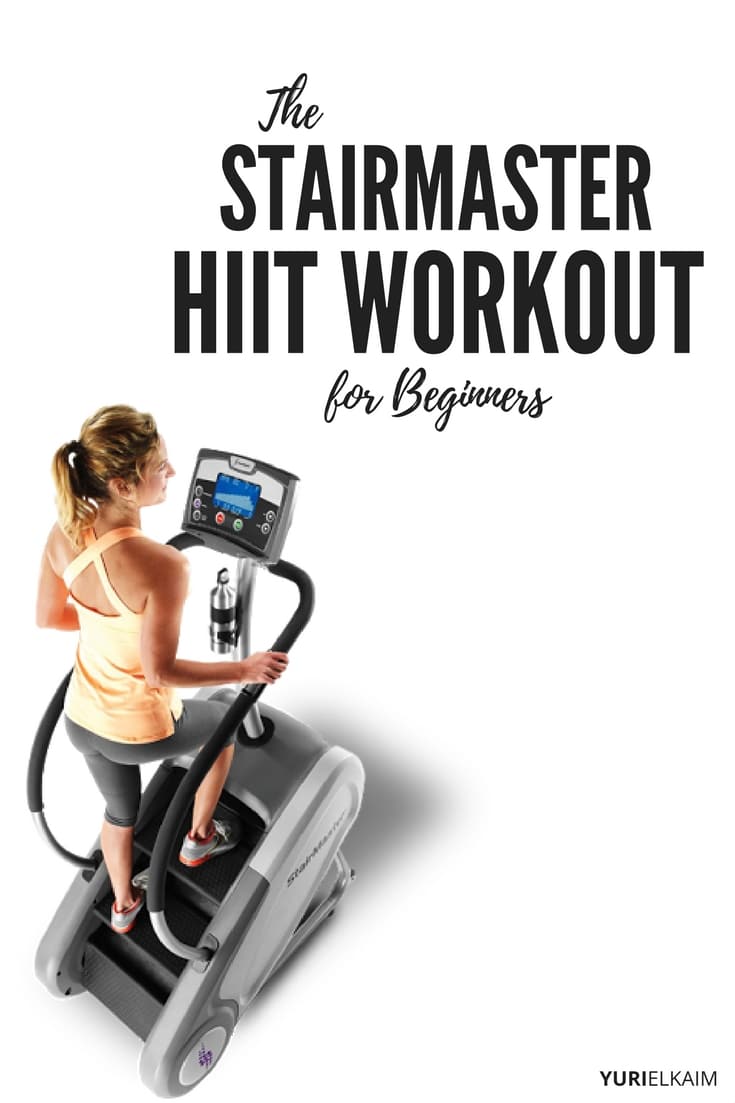Stair machine, step machine, stair mill – it goes by many names.
In this article
In reality, it should be called the Stairway to Cardio Heaven.
Granted, you might not feel heavenly when you’re on it, but trust me: the results will make the climb worthwhile.
So what exactly is this piece of equipment I’ve just painted a halo over?
We’ll call it by its original name: the Stairmaster.
Chances are you’ve seen one in your local gym or even tried climbing aboard one yourself a few times.
The Stairmaster is similar to a treadmill, except it features revolving stairs at a high grade.
Now, if you’ve ever decided to take the stairs instead of riding the elevator up more than a flight or two, you know how deceivingly intense just walking upstairs can be.
Recommended Reading:
That intensity is just one of the amazing benefits of the Stairmaster.
Why You Should Do a Stairmaster Workout
Using a StairMaster enhances your whole body and is a great way to diversify your usual running or walking routine. Read on to learn the benefits of using the Stairmaster, and see why you need to switch from using the treadmill for your HIIT cardio workouts.
1. Serious Fat Burn
As we know (or have at least heard), working out on the Stairmaster is intense.
The best beginner-friendly stairmaster workout for fat loss involves high-intensity interval training (HIIT) and a combination of cardio and strength exercises.
When used as a HIIT workout, the intensity is increased even more, setting up the perfect environment for serious fat burn.
Unlike low-intensity, steady-state cardio workouts (like most typical treadmill workouts), HIIT has been proven to burn fat more effectively than any other type of workout.
This is because high-intensity exercise creates chemical and structural changes to your DNA that increase your number of fat-burning proteins (1). And of course, the more fat-burning proteins you have, the more efficient your body is at using fat as a fuel source, rather than storing it.
Not only that, but high-intensity workouts also boost the release of hormones (including growth hormone), leading to greater muscle growth and fatty acid mobilization (2).
Perhaps the best effect of HIIT workouts – like those we can get with the Stairmaster – is their ability to create a nifty little side effect called “afterburn.”
Officially termed excess post-exercise oxygen consumption (or EPOC for short), afterburn is defined as the number of calories you burn following a workout, rather than during. And nothing creates a bigger afterburn than HIIT workouts.
Why is this?
To put it simply, after a workout your body works to restore your oxygen levels to normal, clear lactic acid buildup from your muscles, and return your body temperature to normal, among other things.
All of these actions require calories. So in essence, the harder you exercise, the harder your body has to work (or the more calories it has to burn) to recover. Burning major calories even when you’re not working out? Who doesn’t want that?
Recommended Reading:
- 10 Cool New Ways to Use Tabata Training for Faster Fat Loss
- 5 Mistakes Most People Make When Doing Tabata Intervals
2. Sculpts Your Stems
Don’t let all of this cardio talk fool you. Once you hop on the Stairmaster, you’ll realize what a powerful lower-body workout you’re in for.
Aside from improving cardiovascular health, Stairmasters also helps strengthen and tone your body, which benefits your bones. The stair motion is similar to that of a step-up on a box, which engages your glutes, hamstrings, quads, and calves to push your bodyweight up and forward.
The great thing is that by changing your angle of walking up the stairs, or by “skipping a step,” as you’ll see below, you can target different areas of the legs and glutes, so you get some versatility in your workout as well.
Recommended Reading:
- The 7 Best Fat Burning Leg Exercises
- The 10 Best Glute Activation Exercises for a Stronger, Tighter Butt
3. Low-Impact, High-Intensity
If you’ve been avoiding adding HIIT to your workout routine due to the belief that all intense exercises are high impact (running, plyometrics, etc…), the Stairmaster might be a way to increase your workout intensity without causing pain.
Walking on the Stairmaster doesn’t involve bouncing or jumping, which allows you to get your heart rate up without jolting your knee joints.
4. Beats Cardio Boredom
Another amazing aspect of doing a HIIT workout on the Stairmaster is the fact that you’ll be in and out of the gym in under 30 minutes.
In fact, if you’re only doing the beginner-friendly Stairmaster workout below, you’ll be out in a mere 15 minutes!
And the best part?
You’ll be burning more fat and seeing better results than you would have if you had spent an hour slowly jogging on the treadmill.
One study showed that three-minute HIIT intervals repeated five or six times created the same muscle and cell adaptations as a steady-state workout lasting 90 to 120 minutes (3).
A year later, the same group revealed through an additional study that HIIT is more effective at burning fat than steady-state cardio.
During the second study, one group performed aerobics while the other started a HIIT regime. At the end of the study, researchers found that the aerobics group burned 48 percent more calories per session than the HIIT group, but the HIIT group burned 900 percent more fat over the 15 weeks than the first group burned in 20 weeks (4).
This effect occurs due to the “afterburn” effect, as well as the DNA changes HIIT induces that I mentioned above.
Do These 4 HIIT Stairmaster Variations
Still, wondering if the Stairmaster is a good workout for beginners? You won’t have any questions about that after you complete this workout.
Before you get started, check out some of the climbing variations this workout calls for, so you can make sure you’re doing them correctly during your intervals.
Here’s an important thing to keep in mind: try not to hang on to the handrails too heavily, as that takes away the intensity of the workout. If you find that you need to lean on the handrails, slow the machine down so you can use proper form.
1. Sprinting
“Sprinting” on the Stairmaster doesn’t necessarily mean flying up the stairs the way you would during a sprint on the ground. The intensity of the stairs, even when increased to just a fast-paced walk, will be enough to feel like sprinting at first, especially if you’re a beginner.
As a general rule, a sprint on the Stairmaster (as with any other work portion of a HIIT workout) should be the speed at which you feel you’re giving at least 75 percent effort. You shouldn’t be able to carry a conversation and your heart rate should be high. Tailor the “sprint” to your individual fitness level based on this.
2. Side Step
The side step involves turning your body to one side and shuffling up the steps. It’s great for working the outer hips and glutes.
Be sure to hold on to the middle railing and turn the speed down so you can comfortably climb sideways. You will alternate climbing sides during the workout. Also, be sure you aren’t stepping only on your toes – try to make sure your heels are also touching the stair treads.
3. Double Steps
Taking double steps, or skipping a step, is another way to up the intensity of the Stairmaster without sprinting. Simply skip a stair with each step you take – your glutes and hamstrings will love you for it!
4. Reverse Step (Optional)
The reverse step is essentially walking backward up the Stairmaster. This is an optional exercise, and I wouldn’t really recommend it until you’re used to the feel of the Stairmaster (no falling off, please!).
However, if you feel up to it, the reverse step puts extra emphasis on your glute and hamstring muscles. You will want to slow down the pace of the machine before you do these, and have your hands near the rail in case you need to catch yourself.
The Stairmaster HIIT Workout for Beginners
As always, don’t forget to warm up with a 5- to 10-minute dynamic warmup consisting of bodyweight lunges, leg swings, and jogging in place before hopping on the stairs.
Perform this workout twice a week for best results. Lengthen the “slow climb” intervals and/or shorten the sprint intervals if you find yourself unable to complete the workout.
Perform three rounds of this HIIT circuit for a total of 15 minutes. Rest for one minute between rounds.
- Interval One: Slow Climb (45 seconds)
- Interval Two: Double Steps (25 seconds)
- Interval Three: Slow Climb (45 seconds)
- Interval Four: Side Steps (60 seconds – 30 seconds on each side)
- Interval Five: Sprint (25 seconds)
- Interval Six: Slow Climb (45 to 60 seconds)
- Interval Seven: Double Steps (25 seconds)
- Interval Eight: Slow Climb (45 seconds)
- Interval Nine: Sprint (25 seconds)
- Rest one minute
Old-School Stairmill HIIT Combo
If you’re looking for a simpler version of this Stairmaster HIIT workout without any fancy footwork, try doing just the slow climb (45 to 60 seconds) followed by the sprint (20 to 30 seconds) for a total of 15 to 20 minutes.
You can also play around with which two variations you use, such as doing double steps in place of sprints, or even side steps in place of sprints.
Pace Yourself For Results
Just remember: if these routines are pretty intense, you’re doing them right.
Again, it’s important not to shy away from intensity during HIIT workouts (or any workout for that matter), because in the end, it’s the intensity that brings results.
This is one of the reasons I love the Stairmaster as a tool for HIIT workouts: it’s close to impossible not to get an intense workout once you get on as a beginner.
Give it a try – I’m sure you’ll fall in love with the results!
Burn More Fat in Less Time
Looking for more ways to boost your fat-burning? Try my Speed Burst Workout!
It’s a follow-along interval cardio workout that’s designed to burn more fat while improving your cardio endurance. And it only takes 5 minutes!
Just click the image below to get your FREE download!






